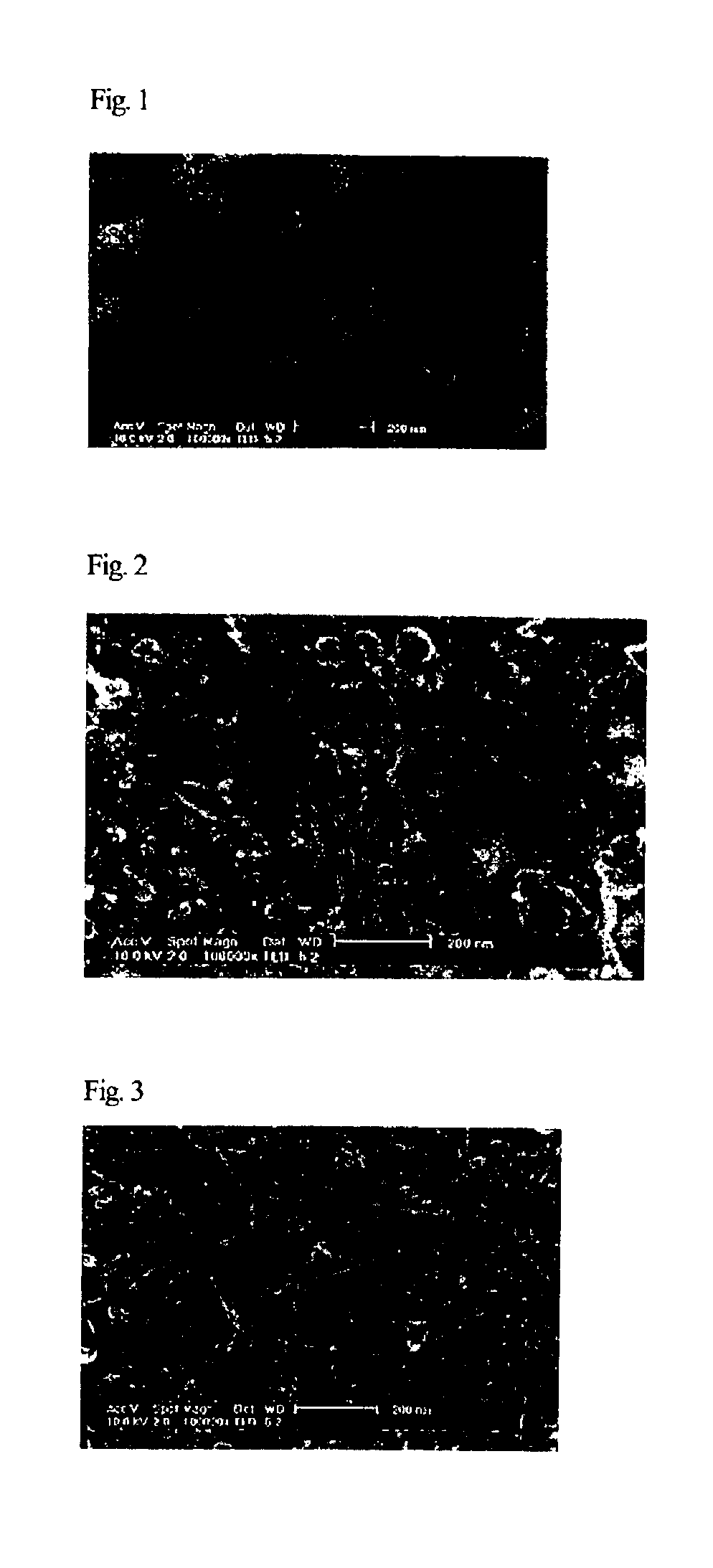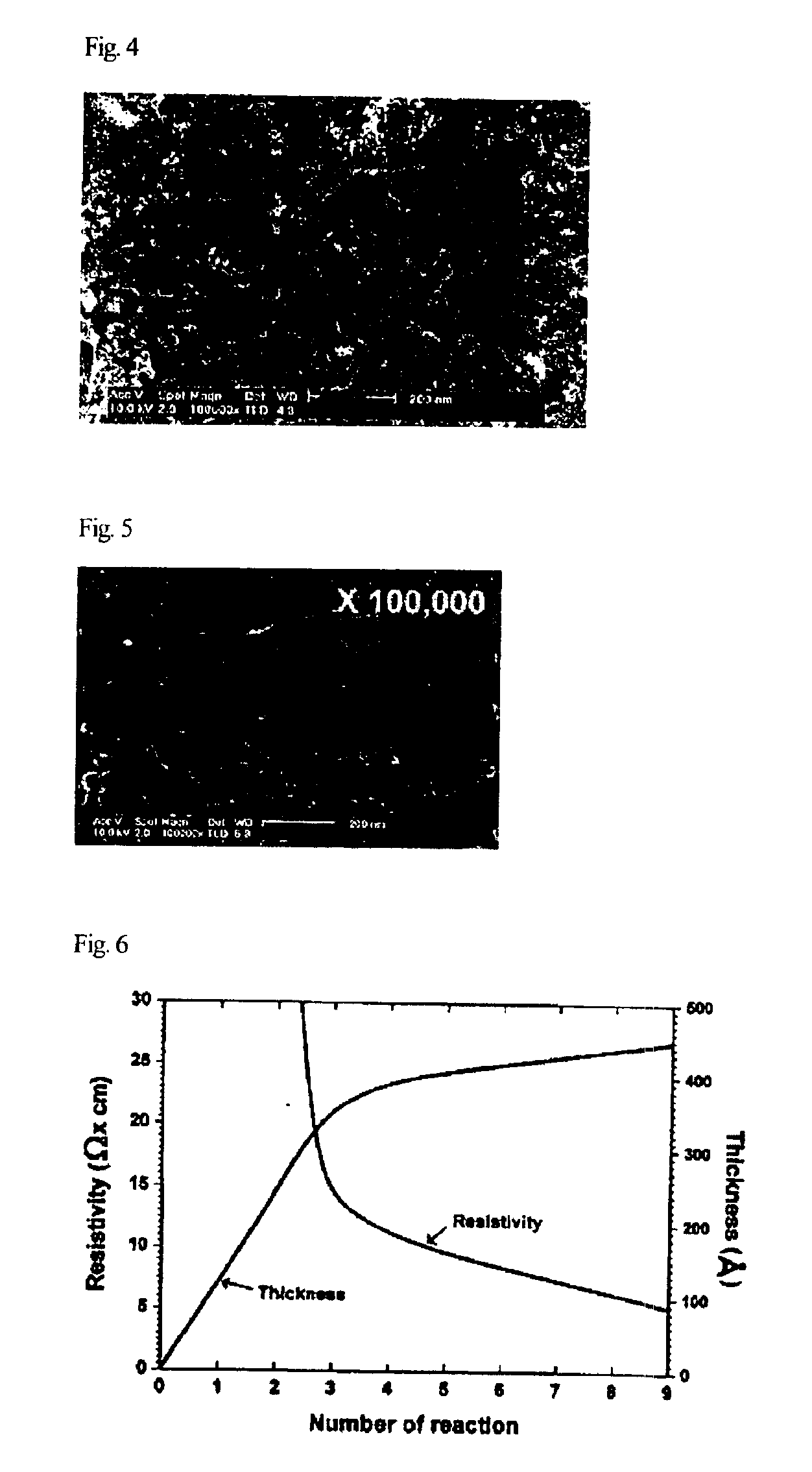Method for laminating and patterning carbon nanotubes using chemical self-assembly process
a carbon nanotube and chemical self-assembly technology, applied in the direction of photosensitive materials, instruments, photomechanical equipment, etc., can solve the problems of inability to anticipate sufficient electrical conductivity on the surface of carbon nanotubes, low surface density of carbon nanotubes, and arranging carbon nanotubes on a substra
- Summary
- Abstract
- Description
- Claims
- Application Information
AI Technical Summary
Benefits of technology
Problems solved by technology
Method used
Image
Examples
example 1
Purification of Carbon Nanotubes
[0087]5 g of carbon nanotubes were dispersed in 700 ml of HNO3 aqueous solution (2.6M) in a 2 L flask equipped with a reflux condenser, and then refluxed at 100° C. for 48 hours. The resulting mixture was centrifuged at 2000 rpm for 30 minutes to separate precipitates and a supernatant of acid solution. The supernatant was removed. Then, the precipitates were dispersed in distilled water, and centrifuged again to remove a supernatant. These series of processes were repeated three times or more. The finally washed precipitates were dispersed in an aqueous solution containing 5% by weight of Triton X-100, and the dispersion was adjusted to a pH of 10 or higher using sodium hydroxide (NaOH). Subsequently, the resulting mixture was subjected to a sonication process for 10 hours, and thereafter 10 g of hydrochloric acid (HCl) was added to precipitate single wall carbon nanotubes. The solution was centrifuged at 2,000 rpm for 30 minutes to separate an aqueo...
example 2
Cutting of Carbon Nanotubes
[0088]1 g of the carbon nanotubes obtained from Example 1 was sonicated in 100 ml of an acidic mixture of sulfuric acid and nitric acid (3:1 (v / v)) for 24 hours using a sonicator. The resulting solution was poured into 500 ml of distilled water, passed through a polycarbonate filter with a pore size of 0.1 μm, and dried under reduced pressure to fabricate carboxylated carbon nanotubes.
example 3
Formation of Carbon Nanotube Monolayer Structure
[0089]A glass substrate was immersed in an alcoholic solution of 0.1% (v / v) aminopropyltriethoxysilane, and the alcoholic solution was stirred at room temperature for 5 minutes. The glass substrate was washed by immersing it in ethyl alcohol three times, and dried in a vacuum oven at 120° C. for 20 minutes. After the dried glass substrate was held under argon gas atmosphere for 12 hours, it was immersed in DMF and sufficiently washed with dichloromethane. Next, 2 mg of the carboxylated carbon nanotubes obtained from Example 2 were dispersed in 200 ml of DMF using a sonicator. To the dispersion of the carbon nanotubes, 2 g of N,N-diisopropylethylamine (hereinafter, referred to as ‘DIEA’) was added dropwise followed by stirring for 10 minutes. Subsequently, 50 ml of DMF dissolving 2.5 g of O-(7-azabenzotriazol-1-yl)-N,N,N′,N′-tetramethyluronium hexafluorophosphate (hereinafter, referred to as ‘HATU’) was added to the dispersion of the ca...
PUM
 Login to View More
Login to View More Abstract
Description
Claims
Application Information
 Login to View More
Login to View More - R&D
- Intellectual Property
- Life Sciences
- Materials
- Tech Scout
- Unparalleled Data Quality
- Higher Quality Content
- 60% Fewer Hallucinations
Browse by: Latest US Patents, China's latest patents, Technical Efficacy Thesaurus, Application Domain, Technology Topic, Popular Technical Reports.
© 2025 PatSnap. All rights reserved.Legal|Privacy policy|Modern Slavery Act Transparency Statement|Sitemap|About US| Contact US: help@patsnap.com



